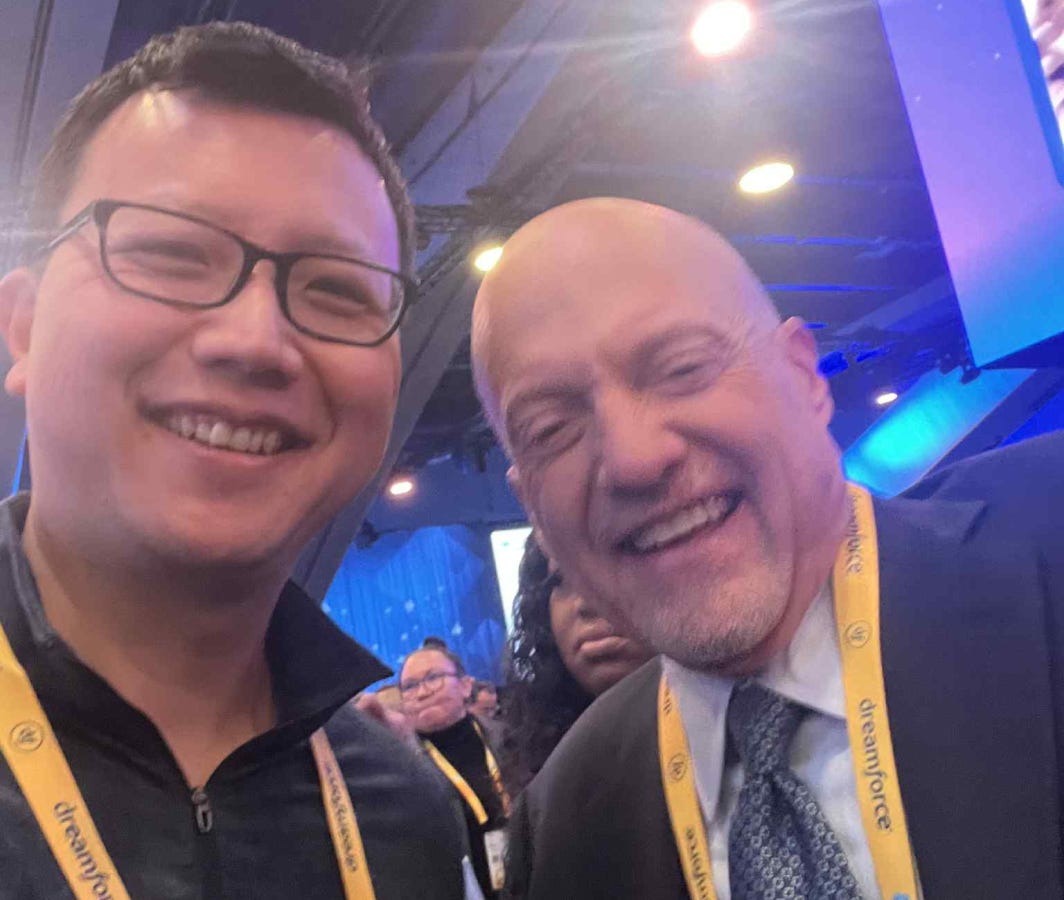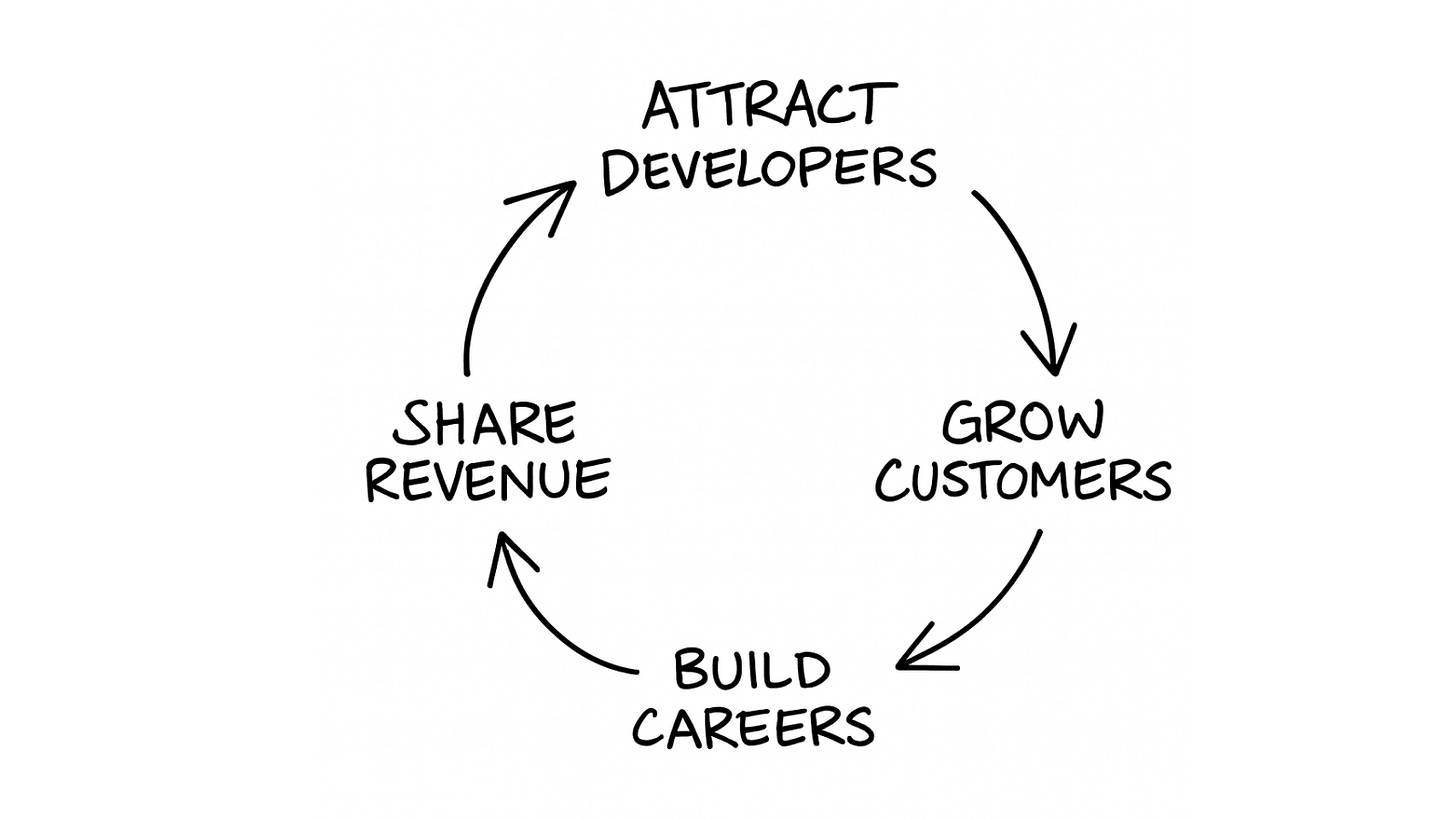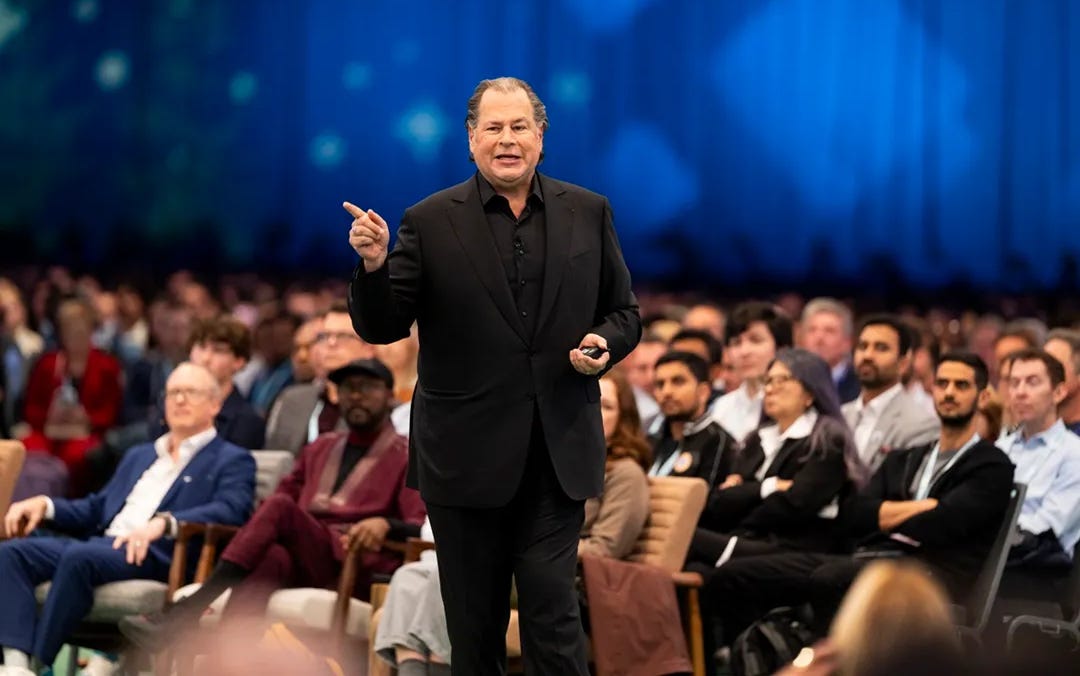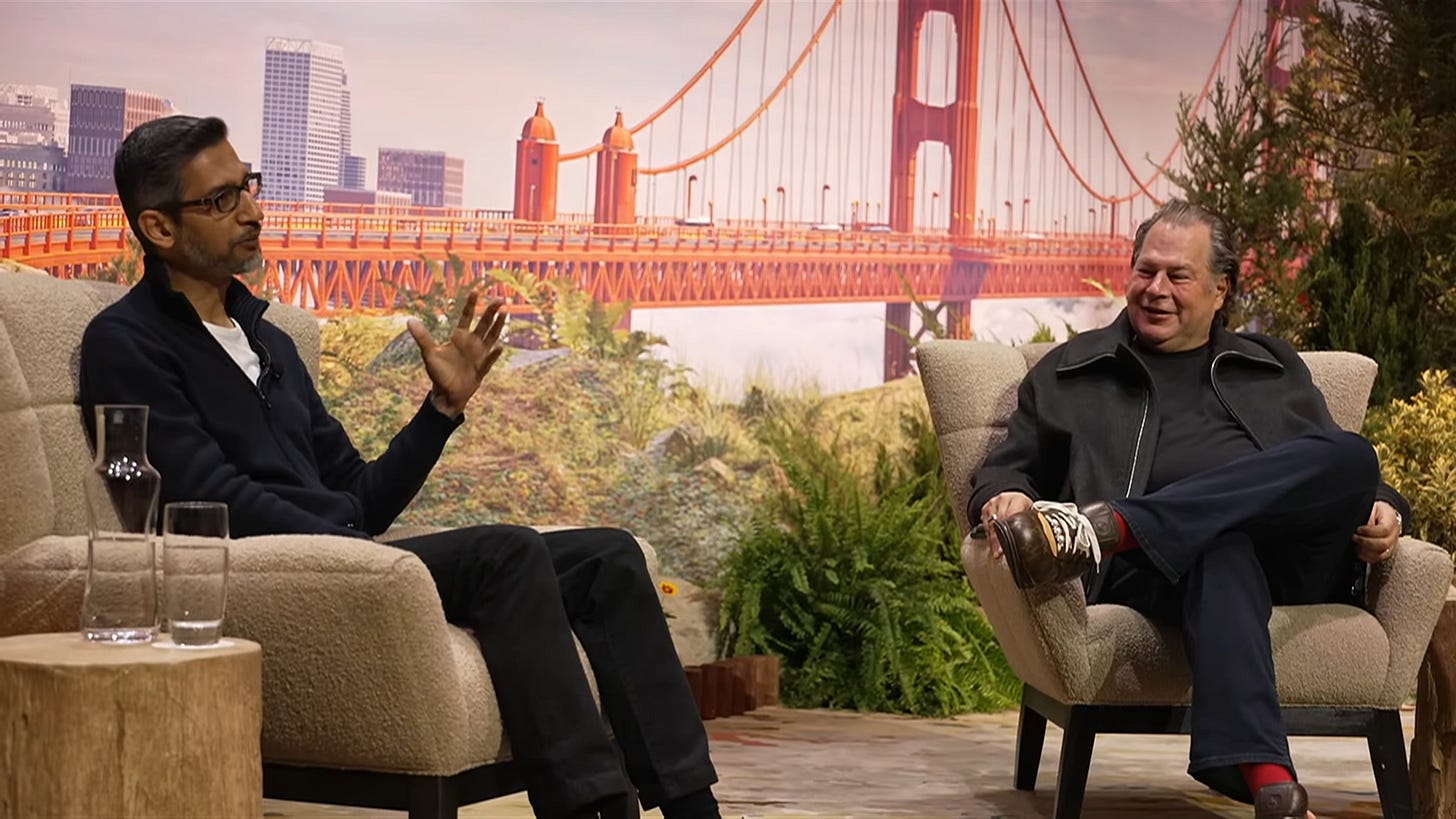What I Learned From Watching Salesforce Pitch AI to 50,000 People
A firsthand look at how a 26-year old CRM company is trying to reinvent itself in the AI era. Disclosure: Salesforce sponsored this recap but all opinions below are my own.
Dear subscribers,
Last week, I went to Dreamforce and wanted to share my experience visiting the biggest conference in tech.
I spent a whole day watching Marc Benioff pitch AI agents to 50,000 people. So here are my thoughts on:
How Salesforce built their partner flywheel
Marc Benioff’s “Agentic Enterprise” vision
Top takeaways from sessions with Dario (Anthropic) and Sundar (Google)
Whether Salesforce can successfully transition to AI
How Salesforce built its partner flywheel
Walking around Dreamforce was surreal. Salesforce covered the entire Yerba Buena area with artificial grass, built a working waterfall, and turned San Francisco into what felt like a corporate Disneyland.
But why would 50,000 people want to attend this conference?
The answer lies in Salesforce’s partner ecosystem. Here’s how it works:
Attract developers: 6,000+ apps have been built on Salesforce’s AppExchange marketplace, including multiple 7-figure businesses.
Grow customers: More apps bring more enterprise customers. 89% of Fortune 100 now use AppExchange apps.
Build careers: Salesforce’s free Trailhead training program has helped 5M (!) people land jobs as Salesforce admins and developers.
Share revenue: Partners pay Salesforce around 15% of their AppExchange revenue in exchange for infrastructure, distribution, and support.
This flywheel is Salesforce’s real moat but can it thrive in the AI era?
Marc Benioff’s “Agentic Enterprise” vision
Marc Benioff certainly wants it to. His “agentic enterprise” vision is one where humans work together with AI agents.
I sat two rows from Marc and he lives up to his reputation as the consummate salesperson. Instead of standing on stage like a typical CEO, he walked around the venue with a robot camera following him. He constantly went off script to greet people in the audience. He was also surprisingly self-deprecating.
I can see why companies would want to partner with him. Marc also spent most of the keynote inviting CEOs from non-tech companies like Williams Sonoma and Pandora to speak. My takeaway is that:
Salesforce is betting that traditional enterprises will adopt AI through their existing Salesforce infrastructure rather than building from scratch with AI-native competitors.
It’s a smart bet given their installed base.
Top takeaways from Marc’s interviews with Dario (Anthropic) and Sundar (Google)
Speaking of AI-native competitors, Marc also interviewed Dario (CEO of Anthropic) and Sundar (CEO of Google). Here are my top takeaways from each interview:
Dario (CEO Anthropic)
Trust beats features when selling AI to enterprises. Anthropic is winning deals by being “the company that is trustworthy and behaves responsibly.” Enterprises do not want flashy demos, they want safety and reliability first.
Revenue is at $7B annualized with 10x annual growth. Dario admits that “It can’t continue like this for much longer. The easy 10x growth years are ending, but we’re still in the explosive phase.”
AI curing diseases makes Dario the most excited. Despite the current hype for AI coding, Dario sees healthcare as the real killer app for AI (he has a biology PhD). “We look at these tough diseases like cancer, like Alzheimer’s — I just think AI is the right thing to cure them.”
Sundar (CEO Google)
Digital super intelligence will be our collaborator. Sundar has an optimistic view that “digital super intelligence will be a collaborator” handling complex tasks with humans. He doesn’t think AGI will replace humans because…
We (humans) are more adaptive than we think. Sundar put his dad in a Waymo self-driving car — “it felt like science fiction” to his father but his kids “got on their phones and they were like whatever.” We constantly underestimate our ability to adapt.
Google Glass could be coming back. The first version failed because the technology wasn’t there. But Sundar is bullish on the future of wearable AI: “Now that you truly have seamless AI with intuitive interfaces — voice, gestures, vision — Google Glass is going to be back and I think it’s going to be great.”
But let’s bring it back to Salesforce…
Can Salesforce successfully lead in the AI era?
I think it’s an open question. Salesforce has several tailwinds working in its favor:
89% of Fortune 100 already use Salesforce apps. This massive base creates switching costs and gives Salesforce a captive audience to upsell AI features to.
Slack is a natural human and agent collaboration interface. Their live demo showed the new Slackbot answering questions and connecting to company data.
Rich CRM data from sales conversations, support tickets, and more can power AI agents that are more personalized for each enterprise.
However, there are also several headwinds:
Agentforce AI adoption is growing but still small. Only 5% of Salesforce’s 150K customers have adopted Agentforce as of this writing.
Salesforce is not an AI-native company. The company has 76K employees and might not be able to move as fast as AI-native competitors.
Overall, this does seem like a bet the company effort for Marc and his team, even if the company is a $240B CRM juggernaut.
Case study: Another new vibe coding tool?
I got a chance to interview Salesforce VP of Product Dan Fernandez, at the conference about Agentforce Vibes — their new vibe coding tool for enterprises.
Yeah you read that right, Salesforce is launching a vibe coding tool in the ultra competitive AI coding market.
Naturally, I had to ask Dan why. His answer:
“When you’re vibe coding a Salesforce app, we do a lot of the infrastructure for you. You don’t need to set up virtual machines, hard drives, or routers — that’s all taken care of.”
It turns out that Agentforce Vibes isn’t competing with Cursor or Lovable. It’s specifically made for building Salesforce apps through:
Browser-based IDE that launches directly from your Salesforce interface.
Semantic catalog that understands your existing Salesforce components and APIs.
Slack integration coming soon for team-based development workflows.
This product matches Salesforce’s broader strategy: Leverage their ecosystem advantages rather than compete head-on with AI-native startups.
It’s all about the partner flywheel that I shared at the beginning of this post.
I left more optimistic about Salesforce’s chances
I went into Dreamforce skeptical that Salesforce can execute on its AI vision.
But I left more optimistic after seeing the company’s partner flywheel in action. I think it’ll all come down to whether the company can transition its ecosystem of 6,000+ apps and 5M+ developers to embrace AI agents.
The next 12-18 months will tell us if Salesforce’s AI transformation is going to work. It’s going to be a fascinating case study to watch.






